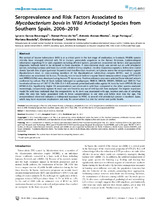Seroprevalence and Risk Factors Associated to Mycobacterium bovis in Wild Artiodactyl Species from Southern Spain, 2006–2010

Ver/
Autor
Pérez de Val, Bernat
Arenas-Montes, Antonio José
Paniagua, Jorge
Boadella, Mariana
Gortázar, Christian
García-Bocanegra, Ignacio
Arenas-Casas, Antonio
Editor
Public Library Of Science (PLOS)Fecha
2012Materia
Bovine tuberculosisM. bobis
Public health
Spain
METS:
Mostrar el registro METSPREMIS:
Mostrar el registro PREMISMetadatos
Mostrar el registro completo del ítemResumen
The control of bovine tuberculosis (bTB) is at a critical point in the last stage of eradication in livestock. Wildlife species
recently have emerged infected with TB in Europe, particularly ungulates in the Iberian Peninsula. Epidemiological
information regarding TB in wild ungulates including affected species, prevalence, associated risk factors and appropriate
diagnostic methods need to be obtained in these countries. A cross-sectional study was carried out on wild artiodactyl
species, including Eurasian wild boar (Sus scrofa) red deer (Cervus elaphus), roe deer (Capraelus capraelus), fallow deer (Dama
dama), Spanish ibex (Capra pyrenaica hispanica) and mouflon (Ovis musimon), in Spain to assess the seroprevalence against
Mycobacterium bovis or cross-reacting members of the Mycobcaterium tuberculosis complex (MTBC), and to provide
information on associated risk factors. Previously, two in-house indirect enzyme linked immunosorbent assays (bPPD-ELISA
and MPB83-ELISA) were developed using known TB status sera. Positive reference sera were selected from infected animals
confirmed by culture. The M. bovis isolates belonged to spoligotypes SB0121, SB0120, SB0295, SB0265 and SB0134. Two
hundred and two out of 1367 (7.5%; 95% CI: 6.1–8.9) animals presented antibodies against M. bovis by both bPPD-ELISA and
MPB83-ELISA. Significantly higher TB seroprevalence was observed in wild boar compared to the other species analyzed.
Interestingly, seropositivity against M. bovis was not found in any out of 460 Spanish ibex analyzed. The logistic regression
model for wild boar indicated that the seropositivity to M. bovis was associated with age, location and year of sampling,
while the only risk factor associated with M. bovis seroprevalence in red deer and fallow deer was the age. The
seroprevalence observed indicates a widespread exposure to MTBC in several wild artiodactyl species in southern Spain,
which may have important implications not only for conservation but also for animal and public health
